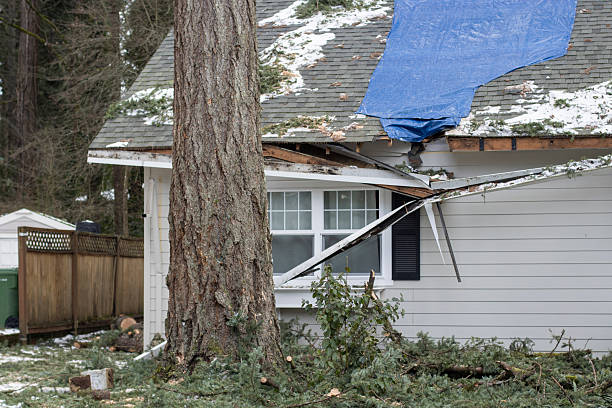Storms can wreak havoc on homes in a matter of minutes, leaving behind extensive damage that requires immediate attention. One of the most commonly affected parts of a house is the roof. High winds, hail, heavy rain, and flying debris can all lead to severe roof damage that compromises your home’s safety and structure. Knowing how to file a roofing insurance claim after a storm can make the difference between a smooth recovery and a long, costly ordeal. For homeowners navigating the stressful aftermath of a weather disaster, understanding the process is crucial for getting the repairs covered and completed quickly.
How to File a Roofing Insurance Claim After a Storm
The first step in the process is assessing the damage. Once it is safe to go outside, take time to inspect your property from the ground. Look for visible signs of roof damage such as missing shingles, bent flashing, dented gutters, or debris piled on the roof. While it’s important not to climb up yourself, you should take photos and videos of the affected areas from every angle. These will serve as crucial documentation for your claim. Understanding how to file a roofing insurance claim after a storm starts with thorough documentation and a careful initial assessment.
Contacting a Professional Roofing Contractor
Your next step should be to contact a reputable roofing contractor to perform a formal inspection. Professional roofers can identify hidden issues that homeowners often overlook. They will assess the full extent of the damage and provide a written report. Some contractors offer assistance with the insurance process and can even meet with the adjuster on your behalf. This not only ensures you receive a fair claim assessment but also avoids future repair delays. Learning how to file a roofing insurance claim after a storm includes knowing when and how to involve experts who can advocate for you throughout the process.
Notify Your Insurance Company
Once you have an inspection report in hand, contact your insurance company immediately. Most policies require that damage be reported within a specific timeframe, often within 30 days. When you call, have your policy number, photos, and the roofing contractor’s report ready. Be prepared to answer questions about when the storm occurred and what damage you observed. The insurance company will likely schedule a time for an adjuster to inspect the damage. Knowing how to file a roofing insurance claim after a storm means acting quickly and staying organized with all your documentation and contractor correspondence.
Meeting the Insurance Adjuster
The adjuster will conduct their own inspection to determine what parts of your claim are covered. It’s wise to have your contractor present during this visit, as they can point out damage, explain the scope of repairs needed, and ensure nothing is missed. This collaboration can be instrumental in receiving full compensation. After the adjuster’s inspection, you’ll receive a statement of loss outlining what will be covered. It’s important to review this document carefully and ask questions if anything seems unclear. A critical part of how to file a roofing insurance claim after a storm is ensuring that the insurance adjuster’s findings accurately reflect the damage.
Understanding Your Coverage and Deductible
Not all homeowner’s policies are the same, and your coverage will depend on your specific plan. Most insurance policies cover damage from hail, wind, and fallen trees, but you’ll need to confirm if any exclusions apply. Your deductible will also play a role in how much compensation you receive. For example, if your deductible is $2,000 and the damage is estimated at $10,000, your insurance company will pay $8,000. Knowing how to file a roofing insurance claim after a storm also means understanding how your coverage and deductible interact so you can plan for any out-of-pocket expenses.
Scope of Repairs vs. Replacement
Depending on the severity of the damage, your roof may be eligible for partial repair or full replacement. Your contractor and insurance adjuster will determine which solution makes the most sense. Insurance companies are more likely to approve full replacement when damage affects more than one area or compromises structural integrity. If only a few shingles are missing, repairs might be sufficient. When learning how to file a roofing insurance claim after a storm, this decision is one of the most impactful on your home’s long-term condition and value.
Hiring the Right Contractor for Repairs
Once your claim is approved, it’s time to begin repairs. Always choose a licensed and insured roofing contractor with a strong local reputation. The contractor should provide a clear contract outlining the scope of work, materials used, timeline, and payment structure. Avoid storm chasers companies that appear after storms and disappear before warranty work is ever needed. By hiring a trustworthy local contractor, you ensure your roof is restored to its original or better condition without future complications.
FAQs
How long does it take to process a roofing insurance claim?
The process usually takes anywhere from a few days to several weeks depending on the insurance company’s efficiency and the complexity of the claim. Staying in touch with your adjuster and providing clear documentation can help speed things up.
Will my premium increase if I file a claim?
In many cases, claims related to natural disasters like storms do not directly impact your premium. However, multiple claims over a short period or claims resulting from poor maintenance may increase your rates. Check with your provider for specifics.
What if my claim is denied?
If your claim is denied, ask for a written explanation and consider a second inspection from a qualified contractor. You may appeal the decision or request a reinspection. Having solid documentation and contractor support strengthens your case.
Can I choose my own contractor?
Yes, you have the right to choose any licensed contractor for repairs. While insurance companies may recommend contractors, you’re not obligated to use them. Choosing your own allows you to select a provider with a proven reputation.
Should I file a claim for minor damage?
Filing a claim depends on the cost of repairs versus your deductible. If the repair cost is significantly higher than your deductible, it’s usually worth filing. However, if the cost is close, it may make more sense to pay out-of-pocket to avoid future rate increases.
Conclusion
Filing an insurance claim for storm-related roof damage can feel overwhelming, especially when you’re also dealing with the stress of home repairs. However, with the right knowledge, documentation, and professional help, you can navigate the process with confidence. From your first inspection to claim approval and final repair, every step plays a role in protecting your home and investment. If you’re still unsure about how to file a roofing insurance claim after a storm, consider working with professionals who can guide you every step of the way. Trust A&S Construction of Louisville for expert guidance, accurate assessments, and reliable roof restoration after any storm.
Author Bio
Written by James Nolan, a roofing and storm restoration expert with years of experience helping homeowners through complex claims processes at A&S Construction of Louisville. James offers trusted insight to ensure your roofing project is handled professionally from inspection to completion. Visit the website to learn more or request a consultation.



















